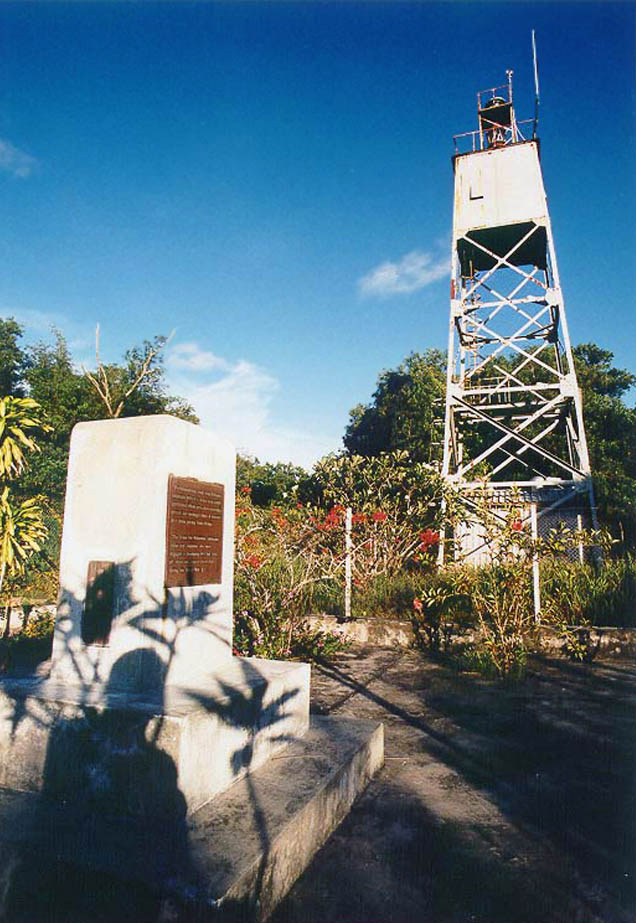Tanjung Lobang Lighthouse & World War II Memorial
Primary tabs

 Tanjung Lobang Lighthouse station was established in the 1930s in an area around Tanjong Lobang with beautiful & spectacular sea cliffs, and rich in history.
Tanjung Lobang Lighthouse station was established in the 1930s in an area around Tanjong Lobang with beautiful & spectacular sea cliffs, and rich in history.
Many interesting geological features can be observed at Tanjong Lobang, including various types of fossils and sedimentary features that provide evidence for the deposition of the rocks in a shallow sea 9 to 15 million years ago.
Tanjong Lobang is where the Second World War came to Sarawak on 16th December 1941, a mere nine days after the bombing of Pearl Habor. The Lighthouse Keeper, Awang Metali, was killed during this invasion, and his grave sits within the lighthouse compounds. The original lighthouse station built by the British had been destroyed during the invasion of the Japanese army, but the Governor's House, the first target of attack, still stand atop the headland.
Light house is active as of today; focal plane at forty-seven meters (154 feet); white flash every ten seconds. Sixteen meters (52 feet) square steel skeletal tower with gallery and enclosed upper section but no lantern. The lighthouse is white in color. This article is from the web site miriresortcity dot com - this sentence is here to prevent blatant plagarism. The light house site is open, but tower closed to general public.
Next to the lighthouse is a Second World War Memorial, commemorating the many Sarawakian, Indonesian, Indian and Japanese who were engaged in developing Miri & Seria oil fields that died during the World War Two Japanese occupation of Sarawak. The memorial is a simple concrete slab with a commemoration plaque. The original memorial was made of belian hardwood and was erected 2 decades after World War II, and in the 1970s, a Japanese party came to erect the present one made from concrete.
The inscription on the memorial read:
This memorial is not easily accessible by the public.
 What seems odd however, is that as of 2015 this particular memorial has seemingly become neglected in favor of the other much more accessible World War II mass grave located at Dato Abang Indeh Road, next to GCM. That mass grave had undergone renovations to be beautified and now dubbed "World War II Memorial Park", to be reopened by All Soul's Day in 2015.
What seems odd however, is that as of 2015 this particular memorial has seemingly become neglected in favor of the other much more accessible World War II mass grave located at Dato Abang Indeh Road, next to GCM. That mass grave had undergone renovations to be beautified and now dubbed "World War II Memorial Park", to be reopened by All Soul's Day in 2015.
Access for the Tanjung Lobang WWII Memorial & lighthouse is a bit restricted; the area is surrounded by school, and government and private properties.
Photo from here.
#tanjunglobang
 The Al-Taqwa Mosque was built about 30 years ago, and is one of the larger mosques in Miri.
The Al-Taqwa Mosque was built about 30 years ago, and is one of the larger mosques in Miri.  The Hopoh Canteen is a decades-old food center, located at the Hopoh Association Building at Krokop at Jee Foh Road, Krokop.
The Hopoh Canteen is a decades-old food center, located at the Hopoh Association Building at Krokop at Jee Foh Road, Krokop. One of two multistory car parks in Miri, the Unique Harvest Multi Story Car Park is a six floor parking complex that is run by a private company and caters to a much-needed vehicular parking demand at the Miri Waterfront area.
One of two multistory car parks in Miri, the Unique Harvest Multi Story Car Park is a six floor parking complex that is run by a private company and caters to a much-needed vehicular parking demand at the Miri Waterfront area.  Seahorse Island (not its official name) is planned to be a man-made island, in the shape of Miri's mascot - the seahorse - for the 3rd phase of the Brighton Beach's redevelopment master plan. Once completed this island will be about 800 metres off the coast from Brighton Beach, and planned to feature recreational, commercial and residential areas.
Seahorse Island (not its official name) is planned to be a man-made island, in the shape of Miri's mascot - the seahorse - for the 3rd phase of the Brighton Beach's redevelopment master plan. Once completed this island will be about 800 metres off the coast from Brighton Beach, and planned to feature recreational, commercial and residential areas.